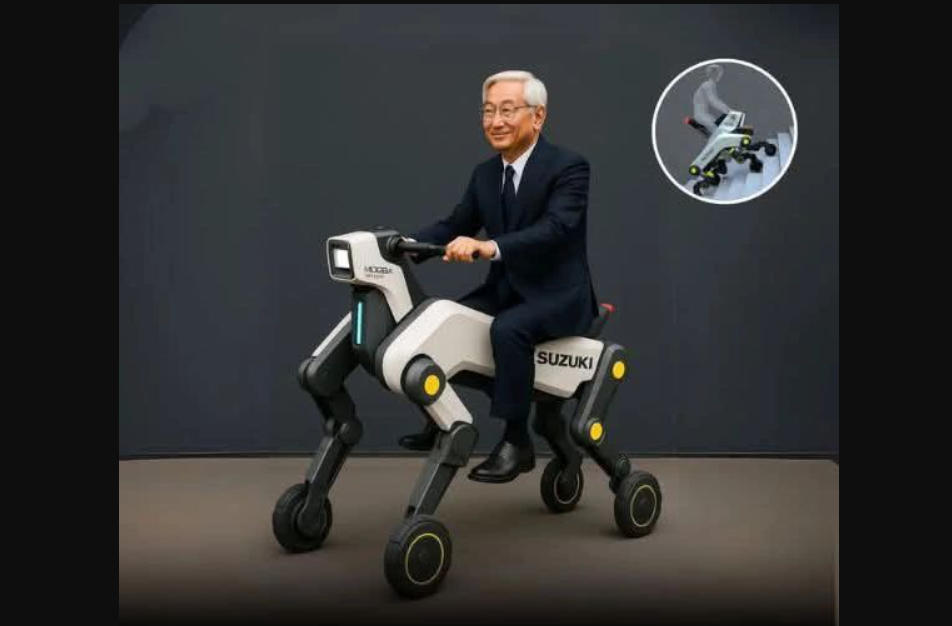Meet the Suzuki MOQBA: a four-legged robotic assistant built to redefine urban mobility. Designed to climb stairs, traverse rugged terrain, and squeeze through narrow alleys, this AI-powered marvel brings together Suzuki’s engineering heritage with cutting-edge robotics. At a price of $3,000, the Suzuki MOQBA is not just a gadget—it’s a leap toward smarter, more adaptive personal and commercial transport solutions.
Why this article? Because tech like the Suzuki MOQBA deserves more than a headline. It demands context, clarity, and real-world relevance. Here, we’ll break down what it is, why it matters, and how it could affect the way cities move. From core benefits and practical uses to important specs and comparisons, we’re putting this machine under the spotlight. Whether you’re into robotics, innovation, or simply curious about what’s next in smart mobility, this is your deep dive.
When and Where Was MOQBA Launched?
Suzuki officially unveiled the MOQBA in early 2025, during a high-profile event in Tokyo, Japan. This was not just a product reveal—it was a bold statement about the future of urban mobility. The launch event was attended by global media, tech analysts, and city planners, all intrigued by what this four-legged robot could offer. With rising demand for smarter urban solutions, Suzuki saw a window to reimagine mobility beyond traditional vehicles.
The rollout will begin in select cities across Japan and Asia before expanding into global markets like Europe and North America. Suzuki chose densely populated urban areas for the pilot programs to test the robot’s navigation systems in real-world scenarios—stairs, curbs, tight lanes, and all. As for availability, pre-orders are open on Suzuki’s dedicated innovation portal. Units are expected to start shipping in late 2025, with full-scale production slated for 2026.
Who Is Behind MOQBA?
The Suzuki Company, a global automotive powerhouse, is the force behind MOQBA. But let’s get specific: Suzuki Motor Corporation, founded in 1909 and headquartered in Hamamatsu, Japan, is where the magic happens. Known for creating compact cars, motorcycles, and outboard motors, Suzuki is now stepping firmly into the robotics space.
The team behind MOQBA includes engineers from Suzuki’s Smart Mobility Division, AI researchers, and roboticists. Collaborations with Japanese robotics labs and smart city planners helped refine the robot’s capabilities. Suzuki’s heritage in efficient engineering made them uniquely positioned to build a compact yet powerful robotic system. While many know Suzuki for vehicles, the MOQBA is proof that this company is evolving fast. If you’ve ever wondered, “What is a Suzu?” or “Suzuki company belongs to which country?”—this robot is a strong answer: Japan, and boldly so.
Why Did Suzuki Create MOQBA?
Urban congestion. Delivery inefficiencies. Accessibility issues. Suzuki created MOQBA to address these mounting urban challenges. As cities grow denser and more complex, the need for adaptable, efficient, and safe transport solutions is more urgent than ever.
MOQBA offers an answer that blends function and futurism. Its AI-powered limbs allow it to carry goods, assist the elderly, and even act as a mobility partner for those with physical disabilities. For Suzuki, this was more than a product—it was a mission. The idea was to create a smart, responsive machine that thrives where wheeled vehicles struggle. Whether it’s delivering packages in high-rise apartments or helping users move through tight alleyways, MOQBA is tailored for modern cities.
Which Markets Will Benefit Most from MOQBA?
Markets with dense populations, aging demographics, or poor last-mile logistics will benefit most. Think of places like Tokyo, Mumbai, or even New York. In India, cities like Suzuki Morbi, Suzuki Mumbra, and Suzuki Moga—where infrastructure gaps exist—could see real advantages from MOQBA’s capabilities.
It’s not just geography—it’s also industry. Logistics, healthcare, personal mobility, and even hospitality could leverage the robot. Hospitals can use MOQBA to deliver medicine; hotels can offer robotic concierge services. The flexibility of the system is key to its wide market potential. Suzuki designed it to fit into multiple verticals without major modifications, making it a versatile solution across many sectors.
How Does MOQBA Work?
MOQBA runs on a high-efficiency AI navigation engine supported by multiple sensors and robotic limbs. Each limb has adaptive joints that mimic the movement of animal legs, giving it the ability to climb stairs and cross uneven terrain with balance and agility. The robot is powered by a lithium-ion battery pack and features an intuitive remote-control interface, with options for AI-assisted autonomy.
The real breakthrough lies in its software. It maps surroundings in real time and adjusts its gait and speed based on terrain feedback. From carpeted halls to outdoor gravel paths, MOQBA learns and reacts fast. Users can command it via smartphone, voice assistant, or an onboard touchscreen. Suzuki didn’t just build a walking robot—they engineered an intelligent urban assistant.
Important Facts About MOQBA
- Suzuki MOQBA Price: $3,000 USD—positioned for mass-market appeal.
- Mobility Range: Travels 10–15 km on a single charge.
- Payload Capacity: Can carry up to 30 kg.
- Speed: Maxes out at 6 km/h, ideal for pedestrian zones.
- Navigation: Uses LiDAR, GPS, and computer vision for pathfinding.
- AI Modes: Manual, semi-autonomous, and full-autonomous.
- Build: Weather-resistant shell; modular frame for accessory mounting.
- User Interface: Companion app, voice control, touchscreen.
- Target Users: Elderly, urban couriers, delivery companies, smart homes.
- Origin: Designed and manufactured by Suzuki in Japan—answering the question, “Suzuki company belongs to which country?”
Top 7 Competitors of MOQBA
- Boston Dynamics Spot – Rugged, powerful, but expensive (~$75,000).
- ANYbotics ANYmal – Industrial grade, limited for consumer use.
- Unitree Robotics Go1 – Affordable, agile, less cargo capacity.
- Ghost Robotics Vision 60 – Military-focused, overengineered for city use.
- Agility Robotics Digit – Bipedal, human-like but less stable.
- Robugtix T8X – Lightweight, but a toy compared to MOQBA.
- Sony Aibo – More of a pet robot, minimal utility.
Pros of Competitors:
- Advanced tech (Boston Dynamics, Agility)
- Established use-cases (ANYmal, Ghost Robotics)
Cons:
- Pricey and complex
- Not consumer-ready or urban-focused
Suzuki MOQBA finds its niche by balancing functionality, cost, and consumer appeal.
FAQs About Suzuki MOQBA
- What is the Suzuki MOQBA?
A robotic transport assistant designed for urban navigation and personal cargo carrying. - What is the Suzuki MOQBA price?
Approximately $3,000 USD. - Suzuki company belongs to which country?
Japan. - What is the meaning of Suzuki?
In Japanese, “Suzuki” is a common surname meaning “bell wood.” - What is a Suzu?
“Suzu” can refer to a small bell in Japanese culture; it also reflects sound and tradition. - Where is Suzuki originally from?
Suzuki originated in Hamamatsu, Japan. - Is MOQBA available in Suzuki Morbi, Mumbra, or Moga?
It will soon be rolled out in multiple urban centers including areas like Suzuki Morbi, Mumbra, and Moga.
Conclusion – suzuki moqba
Suzuki’s entry into robotics with MOQBA is not just innovation—it’s evolution. This AI-powered assistant combines the reliability of Suzuki engineering with the versatility of modern robotics. The Suzuki MOQBA price point of $3,000 makes it one of the most accessible robotic platforms available, designed to change urban mobility. Whether you’re in Suzuki Moga or Suzuki Mumbra, this robot could soon be walking down your street.
For a company that many associate with compact cars and motorcycles, this leap into AI mobility answers questions like “What is a Suzu?” or “Suzuki meaning in English” in action—not just in words. It’s about creating tools for a better tomorrow. Suzuki, a company with roots in Japan and a legacy of innovation, is once again proving why it’s a name worth knowing. And as the world shifts to smarter, smaller, and more sustainable transport, the MOQBA stands at the ready.



